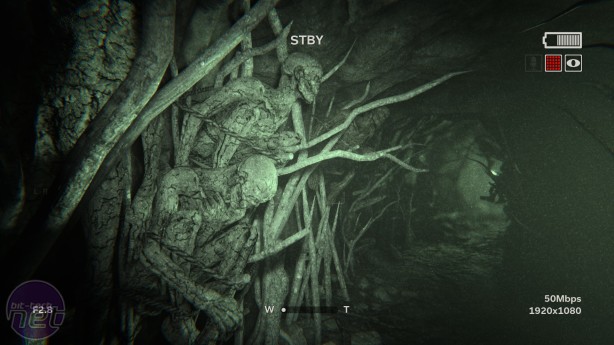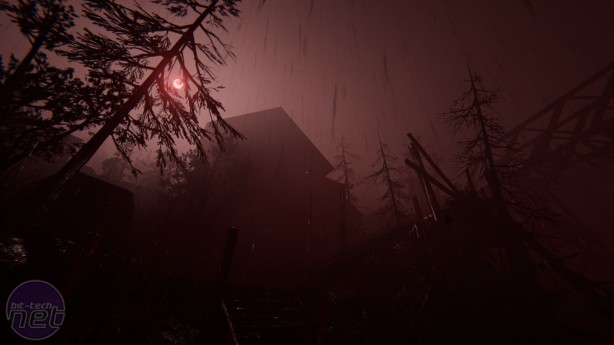
Outlast 2’s lighting engine may be haunting and subtle, but its horror most certainly is not. Within the first 20 minutes of play, the game has the player walk across a pit filled with the corpses of newborn babies. That’s how it starts. From this moment onward, Outlast 2 is a barrage of atrocious imagery and events that target any potential trigger point the developers can think of. Torture, body horror, crucifixion, infanticide, claustrophobia, disorientation, madness, sexual depredation. The developers aren’t interested in slowly amping up the terror but beating you about the head with it until you collapse, shuddering and exhausted. Oh God, it’s all coming back to me… no. NO! Quick! Here’s a lovely wee dog.
The game is not subtle, then, but I must confess that it is effective. Within this juggernaut of terror are some smarter ideas too. Threaded through Langermann’s journey is a secondary story about his time at Catholic school and his childhood memories of a girl called Jessica. What makes these sections particularly interesting is how they’re seamlessly interwoven with the level design of the main game. For example, climbing through a wooden hatch inside an Arizonan shack may lead into the school’s ventilation system, while leaping out of a school window may leave you dangling over a cliff above an Arizonan river. As you progress deeper into the game, the two locations alternate more frequently. This lends Outlast 2 an increasingly surreal edge, casting doubt on whether Blake’s experiences are real or a religious manifestation of long-suppressed guilt.
Red Barrels couples this fracturing reality theme with some cleverly designed set-pieces. Arguably the best is one you might have already played, wherein Langermann is hunted through a cornfield by torch-wielding Christian zealots. It is incredibly tense. The corn conceals you effectively, meaning enemies can come within feet of you without being alerted to your presence. At the same time, you’re effectively blind, feeling your way toward the exit, while constantly having to change direction when a torch beam sweeps across the corn in front of you. Another much later sequence involves navigating a half-submerged mine, ducking underwater to evade the eyes of a patrolling heretic.
Red Barrels excels in creating hiding places that force you into a compromise, and it’s during these deadly games of hide-and-seek where Outlast 2 is at its strongest. So it’s unfortunate that these sequences are far less frequent than in the first game. Outlast 2 prioritises being chased rather than being hunted. In fact, so often are you legging it away from some terrible foe that, although Outlast 2 is technically a larger game than the first, it has a slightly shorter running time (pun not intended).
Obviously, Red Barrels wants to outdo the previous game in terms of scares, and part of its approach is to up both the momentum and intensity of the horror. They are good chase sequences too, mostly. There are a few where the developers are a little too nasty to the player, particularly during the midsection of the game, which largely takes place in a forest. Generally, though, the environments are complex enough to induce panic while giving you just enough of a hint of where to go next. My favourite example began by dumping me straight out of a school section into the face of an enemy and involved crawling beneath the foundations of a house to escape. In most games, this is where a chase sequence would end. Not Outlast 2, sonny jim! They keep coming after you. Eurgh. Deploying emergency kitten!
Personally, though, I believe the overall result of this is a less interesting game. To begin with, the whole experience is too choreographed. Outlast 2 is less Alien: Isolation and more a Call of Duty game that’s been left to rot in the back of a cupboard for several years. Even in areas where it does allow you some freedom to sneak around, the environments are often so constricted that it’s easier to just blast through them and get the chasing over with. This is also why the directional microphone mechanic doesn’t succeed. Even when enemies move away from your position, it’s difficult if not impossible to avoid being spotted when sneaking forward.
Moreover, a large part of my enjoyment of the first Outlast stemmed from solving the mystery behind the Murkoff insane asylum. I felt inclined to proceed into dangerous and frightening situations because I was genuinely curious about what was going on. In Outlast 2, all I wanted to do was get away from whatever was currently trying to gnaw on my spine. Toward the conclusion, the chasing becomes so frequent and so intense that I lost interest in the story and was focussed solely on survival.
What doesn’t help is that the breadcrumb trail you follow isn’t as well thought out as the original. Most of the text documents you pick up to shed light on events are from the Gospel of Sullivan Knoth - the founder of the depraved sect of Christians you’re trying to escape from. These are big chunks of pseudo-biblical text, a lot of which is basically rambling nonsense. While this certainly adds flavour to the proceedings, it didn’t satisfy my curiosity about what exactly happened in this place. The scattering of pages from Knoth’s gospel also feels more artificial than the documents knocking around Murkoff Asylum. Perhaps this is an inevitable consequence of a rural, low-tech setting, however.
All of this meant I found Outlast 2 to be less involving than its predecessor. As I said at the outset, it’s a ghost-train to the first game’s haunted house, with less emphasis on mystery and exploration and more on 'Argh! Oh God, what’s that, run away, RUN!' It still did an excellent job of playing my nervous system like a harp, but it did so by repelling me away from its lurking horrors rather than drawing me in. It’s a decent sequel, but not a great one.
The game is not subtle, then, but I must confess that it is effective. Within this juggernaut of terror are some smarter ideas too. Threaded through Langermann’s journey is a secondary story about his time at Catholic school and his childhood memories of a girl called Jessica. What makes these sections particularly interesting is how they’re seamlessly interwoven with the level design of the main game. For example, climbing through a wooden hatch inside an Arizonan shack may lead into the school’s ventilation system, while leaping out of a school window may leave you dangling over a cliff above an Arizonan river. As you progress deeper into the game, the two locations alternate more frequently. This lends Outlast 2 an increasingly surreal edge, casting doubt on whether Blake’s experiences are real or a religious manifestation of long-suppressed guilt.
Red Barrels couples this fracturing reality theme with some cleverly designed set-pieces. Arguably the best is one you might have already played, wherein Langermann is hunted through a cornfield by torch-wielding Christian zealots. It is incredibly tense. The corn conceals you effectively, meaning enemies can come within feet of you without being alerted to your presence. At the same time, you’re effectively blind, feeling your way toward the exit, while constantly having to change direction when a torch beam sweeps across the corn in front of you. Another much later sequence involves navigating a half-submerged mine, ducking underwater to evade the eyes of a patrolling heretic.
Red Barrels excels in creating hiding places that force you into a compromise, and it’s during these deadly games of hide-and-seek where Outlast 2 is at its strongest. So it’s unfortunate that these sequences are far less frequent than in the first game. Outlast 2 prioritises being chased rather than being hunted. In fact, so often are you legging it away from some terrible foe that, although Outlast 2 is technically a larger game than the first, it has a slightly shorter running time (pun not intended).
Obviously, Red Barrels wants to outdo the previous game in terms of scares, and part of its approach is to up both the momentum and intensity of the horror. They are good chase sequences too, mostly. There are a few where the developers are a little too nasty to the player, particularly during the midsection of the game, which largely takes place in a forest. Generally, though, the environments are complex enough to induce panic while giving you just enough of a hint of where to go next. My favourite example began by dumping me straight out of a school section into the face of an enemy and involved crawling beneath the foundations of a house to escape. In most games, this is where a chase sequence would end. Not Outlast 2, sonny jim! They keep coming after you. Eurgh. Deploying emergency kitten!
Personally, though, I believe the overall result of this is a less interesting game. To begin with, the whole experience is too choreographed. Outlast 2 is less Alien: Isolation and more a Call of Duty game that’s been left to rot in the back of a cupboard for several years. Even in areas where it does allow you some freedom to sneak around, the environments are often so constricted that it’s easier to just blast through them and get the chasing over with. This is also why the directional microphone mechanic doesn’t succeed. Even when enemies move away from your position, it’s difficult if not impossible to avoid being spotted when sneaking forward.
Moreover, a large part of my enjoyment of the first Outlast stemmed from solving the mystery behind the Murkoff insane asylum. I felt inclined to proceed into dangerous and frightening situations because I was genuinely curious about what was going on. In Outlast 2, all I wanted to do was get away from whatever was currently trying to gnaw on my spine. Toward the conclusion, the chasing becomes so frequent and so intense that I lost interest in the story and was focussed solely on survival.
What doesn’t help is that the breadcrumb trail you follow isn’t as well thought out as the original. Most of the text documents you pick up to shed light on events are from the Gospel of Sullivan Knoth - the founder of the depraved sect of Christians you’re trying to escape from. These are big chunks of pseudo-biblical text, a lot of which is basically rambling nonsense. While this certainly adds flavour to the proceedings, it didn’t satisfy my curiosity about what exactly happened in this place. The scattering of pages from Knoth’s gospel also feels more artificial than the documents knocking around Murkoff Asylum. Perhaps this is an inevitable consequence of a rural, low-tech setting, however.
All of this meant I found Outlast 2 to be less involving than its predecessor. As I said at the outset, it’s a ghost-train to the first game’s haunted house, with less emphasis on mystery and exploration and more on 'Argh! Oh God, what’s that, run away, RUN!' It still did an excellent job of playing my nervous system like a harp, but it did so by repelling me away from its lurking horrors rather than drawing me in. It’s a decent sequel, but not a great one.


MSI MPG Velox 100R Chassis Review
October 14 2021 | 15:04














Want to comment? Please log in.